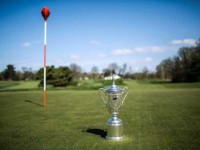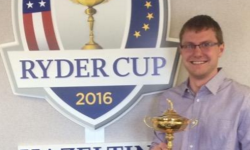As I eagerly await restart of play on Thursday morning of our national championship, I begin to question how low these craftsmen of steel and iron can really go.
In the 2011 U.S. Open, young stud Rory McIlroy astounded the golf world with his runaway, eight shot victory at a rain-soaked Congressional Country Club. Let’s not forget that he backed it up with another eight shot victory at Kiawah in the PGA Championship last fall. Though Congressional played quite lengthy at just over 7,500 yards, competitors faired well as 20 players posted scores under par for the tournament. With this in mind, the key question lingering amongst fans and gurus alike is what that winning number will be in a similarly rain-ridden US Open Championship.
Judging on what I've seen thus far, it seems that magical number will be one in the red figures, but how low will they go? Looking at Merion on paper, four yards under 7,00 yards doesn’t seem so daunting, but neither did the 7,170-yard track at Olympic Club last summer that halted a triumphant number of one over par to champion Webb Simpson.
Lee Trevino with his infamous “Rubber snake” prior to his playoff with Jack Nicklaus.
Scores at Open's held at Merion have improved over time. In 1934 the US Open was held at Merion for the first time, Olin Dutra captured the title at +13, defeating Gene Sarazen by one shot. In 1950, Ben Hogan defeated Lloyd Mangrum and George Fazio in a playoff with a winning score of +7. Lee Trevino also went on to beat “The Bear,” Jack Nicklaus in a playoff in 1971 as they both finished the weekend at even par. Ten years later, David Graham went on to take the cup with a score of -7. If history continues its trend, lookout for some extremely low scores.
But not so fast.
In addition technological improvements which have helped lower scores, one thing that has not lowered is the purses pros now receive for taking home our nation's golf championship:
|
Year |
Tournament |
Winner |
Winner's |
|
1,000 |
|||
|
U.S. Open |
4,000 |
||
|
U.S. Open |
30,000 |
||
|
U.S. Open |
55,000 |
||
|
U.S. Open |
June 13–16 |
1,440,000 |
Despite Marion's lack of length, it’s tough to consider this challenging layout surrendering a plethora strokes to the field. Merion presents an artful mixture of long and short holes, described by many as a three-act play. The first six holes open as The Drama to which players must retain patience in getting their round going. The Comedy (holes 7-13) give the players a sense of ease with numerous scoring opportunities, but alas, if one doesn’t take advantage, he will be fighting for his life on his way back into the clubhouse. The course’s final five holes sets up for The Tragedy, a combination of awkwardly long holes that will have spectators on edge on Sunday evening. In the previous two Opens held at Merion, the field averaged a well-over-par score on its final five-hole stretch.
All in all, I foresee this being one of the better championships we will see this year. The course will be the perfect test of patience, touch, length, damage control, and will to win. I don’t know if we will see a shootout by any means, but then again the amount of talent as well as parity on Tour ceases to amaze me week in and week out. One thing I do know, however, is that each day will prove to be a three-act test which every competitor is going to have to battle through if he wants to raise the cup on Sunday.
Austin’s Predictions
Winning score: -5
Picks: Tiger Woods, Dustin Johnson, Steve Stricker
Outside chance: Luke Donald, Zach Johnson, Rickie Fowler
Low Amateur: Michael Weaver
**Connect with the NCCGA on Twitter @NCCGA




